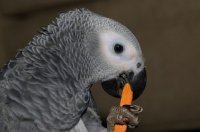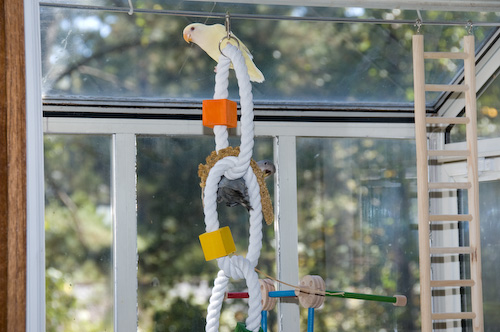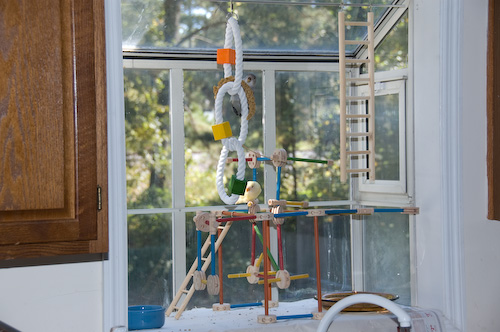NEW ADDRESS FOR MEMBERS GREYFORUMS.ORG
-
Posts
267 -
Joined
-
Last visited
Content Type
Profiles
Forums
Events
Gallery
Everything posted by Kaedyn
-
You may have more luck with the Aviator harness mainly because the straps aren't as tight against the bird's body. He may still chew the straps, but hopefully he won't touch his feathers while doing so. Also, the straps are really strong and can take a lot of chewing.
-
It's not cheap, but this is what I keep near my cages, for trips in the car and emergency get aways. http://www.flyingsouth.com/index.asp?PageAction=VIEWPROD&ProdID=27 The canvas is removable and can be cleaned. The top of the canvas has a zippered pouch for supplies. The cage itself is stainless steel. Hence, why it costs as much as it does. Oh! I forgot to mention, in case it's not obvious, it's a backpack! I also keep several first aid kits all in Sterilite containers. The containers are large enough to serve as emergency transports for trips to the vet.<br><br>Post edited by: Kaedyn, at: 2008/08/17 19:36
-
I could swear it was someone on this site that mentioned it, but I just can't seem to find the original post. They placed a few treats in a translucent pill box. The kind with one door for each day of the week and let their parrot figure out how to get to the treats. I don't know how safe the plastic is, so I recommend that this be a supervised foraging game. I've used it with my own and they get fairly excited while trying to free their apple cinnamon Cheerios. I've also added some foraging toys to their cages. My favorite one is the Birdy Einstein Zig Zag: http://www.thepinkbird.com/zigzagpuzzletoy.aspx It takes a bit of work to rock the wheel back and forth, so that the treats make their way through the maze. In case you're interested, I can vouch for the Pink Bird site. I've ordered from them several times, they ship quickly and their service has been great.
-
Actually I think Harley (the grey one) is holding onto the millet for dear life, because Behati (the yellow one) is soon to steal it from him. That's just part of a normal day for poor Harley. He gets his after she gets hers. Even if it's something she really doesn't even like!
-
One thing you might try is distractions. Always use positive measures to counter undesired behaviors. So, if you know of some toy which your bird really loves, keep it nearby and use it to divert attention away from your fingers. You could also try a walk around the house, etc.
-
My new female CAG did something similar when I brought her home. She actually had a lot of very loud sounds, which I never remember my male doing at her age. I brought her home at around 4 months and she's into month 5 now. Prior to my bringing her home, she lived with other greys, conures, amazons, and a macaw, so I think that's where she learned to be really loud. It's hard to stand out in the crowd and get attention with all those other really loud birds screeching away. She's grown out of the worst of it, but unlike my male who is fairly quiet, she can be really shrill when she feels like it. It's even better when her beak is right next to my ear. I'm sure it must be an OSHA violation.
-
Congrats! The waiting is the hardest part. If my breeder had a guest room, I'd have moved in.
-
You're probably reading about abundance weening. Three years seems over the top, but the point is to continue feeding your baby their formula, while at the same time offering them a variety of solid foods. Eventually they'll get to the point where they refuse the baby formula. The purpose behind it is not only for nutrition, but it tends to produce more emotionally stable parrots. For my own birds, I'd say it was somewhere in the 4th month that they completely refused their formula.
-
TAGs being a slight bit smaller than a CAG should probably have around a 0.75 inch bar spacing. If she is able to get her head through the bars, that's not good. Did you purchase the cage from the same shop that made the recommendation? If so, do you think they'll allow you to exchange it?
-
I have a 5 month old that still does that from time to time. In her case, she either wants more food, another food, or is just trying to get me to hold her beak with my fingers, so she can "share" her food with me. That last is usually a sign of affection, but not really one you'll want to encourage. My bet is that your bird just really loves you and is trying to show you the only way she knows how. I tend to just ignore that behavior or attempt to distract her with toys.
-
I should have pointed out the vet wrap in the original post. If you look at the photos, it's the purple coloring at the top of the perch. It makes them much more comfortable for your bird and adds needed grip.
-
Mel, Thanks for the nice comments! It's not at all unstable front-to-back, but it does sacrifice just a bit side-to-side for portability. I've been using them for quite a while. In the early days, there were one or two times when they managed to rock it slightly to the side, but it never fell over. Considering the moving branches they may climb or perch on in the wild, I don't think this was much of a challenge for them. They learned very quickly how not to rock the perch. They preen on it all the time and it stays planted solidly on the floor. Typically they are flying from the perch to me or their cages, so I can't really speak for flying to the perch. If it does become a concern, all you have to do is replace the four pipes going side-to-side with some just slightly longer. You could also shorten the two pipes which give it height, to make it less top heavy. When I first put it together, I was a bit concerned that it needed to be wider and longer at the base, but it hasn't been a big issue. I'd be more concerned with someone walking by and bumping it sideways, than with my fids tipping it. They do sell longer pieces of the pipe-snap-clamps, so you can make it as wide as you need to for your fids and your own comfort level.
-
Rigel started at around 4 months. His "hello" was fairly clear, but a lot of other words were garbled. You could usually count the syllables and know that he was on target. Of course, it didn't help that one of the words was "Cheerio". His vocabulary is much larger now that he's over a year old, but not everything is that clear. My second grey is just under 5 months and hasn't really said much. At 13 weeks she would say "ut-oh" if she or something fell, but she's gradually stopped. It was something she learned from the breeder's flock.
-

He steps up! And some other random observations
Kaedyn replied to Refunds_Mom's topic in The GREY Lounge
It's good to hear that you're making progress! I have both a male (13 months) and a female (5 months). There is definitely a size difference. I also weigh them fairly often and shes about 100 grams lighter. Of course, she's a lot younger and might put on more weight, but I doubt she'll catch him in height. -
I posted some pictures of the Tinkertoy playgym in the Other Birds forum for anyone who is interested. Enjoy! http://www.greyforums.net/forums/other-birds/88374-lovebird-tinkertoy-playgym.html
-
-
I made mention of my lovebird Tinkertoy playgym in another post and here is a picture of what it looks like. This is one of their favorite locations to play in the house.
-
n2fisher: I currently have four--two greys and two lovebirds. The lovebirds get along with each other, but I don't let them out near the greys. The really small birds seem to be more aggressive than others, with complete disregard to size differences. I grew up with multiple birds in the house and even had a Timneh sharing the same cage with a lovebird, but that's probably a very rare situation. I also have two greys. My oldest is about 13 months and my youngest is under 5 months. I'm still in the process of introducing them to each other. In the beginning, my older grey was a bit jealous, but that's starting to wear off. Their cages are in the same room and when out on the portable perches, I sometimes sit them just close enough that they can't ignore the other, but also can't quite reach each other. I've also had them out on the floor together playing with toys. For the most part, they pretend the other isn't there. When they do get close, my youngest tends to lower her head and make cooing noises. My oldest cautiously reaches in her direction and acts like he's trying to bite the top of her head. I think he's really just trying to touch her head with his tongue, but I'm staying on alert just in case. That scenario usually ends with her moving and him getting startled, then pulling back. My oldest is a big chicken. The portable perch is a bit small for the two greys, so I have one for each of them. The lovebirds both fit on it just fine, but they also have a Tinkertoy playgym near the window that they play on. I'll have to post a picture of that sometime. For extended stays, I have a much larger version of the portable perch which has feeders, toys, etc. That one would be large enough for two at once, but I don't think they are ready to share. I also have a large net with toys suspended from the ceiling in their room for solo playtime.
-
I didn't use any glue, since it really holds together well under it's own strength and I also like to mix and match parts as necessary. I have a second one which looks about the same, but the tall poles are cut in half and then coupled together. This allows me to remove 2 feet of height when I need a low perch, such as training when I am sitting down. It also allows me to disassemble the entire contraption and throw it in a duffle bag for even more portability. No part is longer than 2 feet. If you build your own, definitely let me know how it works out. My fids love to be everywhere I am and that's what prompted me to build it in the first place. When I run downstairs to wash some clothes, or am at the sink washing dishes, I just tote them along.
-
You can always hang some foot toys from the portable perch, but I have a much wider version of the same perch for longer stays. That one has a few toys hanging from it, along with food and water cups. The 90 degree elbows at the top are replaced with t-connectors, allowing me to extend a piece of PVC overhead and have toys hanging above and below. That's the great thing about PVC, if it doesn't do what you want, you just change it. It's kind of like legos.
-
With all the talk of PVC playstands and perches, I thought I'd share the portable perch I built, which allows me to tote my fids around the house with me and not worry about droppings. I use this one when doing chores around the house, during TV time late at night, when I am shaving, etc. They really like to hang out in the bathroom and sing while I shave. This is also a good perch for training, since there are no food or toy distractions. It's very portable and as you'll see, the secret of this perch is that the poop-paper travels with it! I built this one using furniture-grade PVC, which has no writing and has a shiny finish. All of the parts were ordered online. If you don't care about the matching shiny finish, you can get all but two of the parts from your local home store. I purchased everything in the pictures below from ACF Greenhouses at http://www.littlegreenhouse.com/accessory/pvc.shtml I built the entire perch using three of the 5' sections of 1" PVC from the site, along with the other specialty components. For those interested in the dimensions of each cut component, they are as follows and all using 1-inch PVC. -------------------------------- 2 - 4" pipe snap clamps 4 - 9" 4 - 5-3/4" 2 - 48" 6 - 90 degree elbows 2 - 4-way connectors I was only able to find the snap clamps and 4-way connectors online. All purpose heavyweight paper 12x24 -------------------------------- The real secret is the pipe-snap-clamps, which allow me to wrap the paper around the PVC and lock it in place by snapping them over the PVC pipe. The perch is small enough to fit almost anywhere and light enough to carry around the house, with the safety of knowing the paper will catch all the droppings. The pipe-snap-clamp shown below. All components cut to size. Perch view #1 without paper. Perch view #2 without paper. View of the perch floor with paper and clamps attached. One CAG added for perspective.
-
A good tool for removing feathers like that is a hemostat. You clamp it onto the feather and it locks in place, allowing you to concentrate on pulling the feather out straight and not at an angle. When doing so, always grasp the feather with the hemostats perpendicular to the feathers length (at 90 degrees with the feather) then pull the feather out smoothly and perfectly straight. I keep two first aid kits on hand just for this sort of situation. It has hemostats, along with a syringe full of styptic powder to stop the bleeding. Other items in the container are bandages and vet wrap for wing and leg splints, hydrogen peroxide, chlorhexidine, stainless scissors, and cotton balls. Best of all, the Sterilite container for the kit itself can serve as an emergency travel cage for the trip to the vet.
-
Hopefully some others with more experience in this area will chime in, but when this happened to mine, I used pure aloe and it healed up just fine. This isn't an uncommon type of injury, even for a flighted grey.
-
As kitty said, music can help. My birds do have the company of other birds, but to me, it really doesn't seem to make as big a difference as when I play some music. Of course, that's just my personal experience. Each bird has their own personality and others experiences may be different. In my case, I created a playlist in iTunes with "bird-safe" music, since there are a few songs I'd rather not have to hear them repeat over and over.
-
Sitcasue. Check out my article called "Bathing Our Parrots" under the "Health and Nutrition" tab at the top of the page. It might give you a few ideas.



